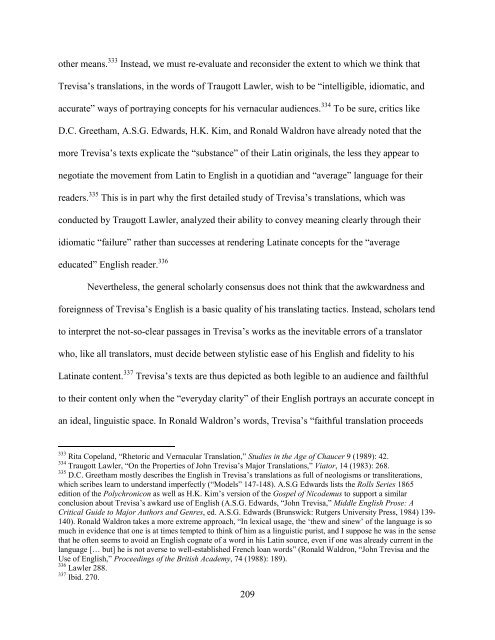WRITING AUTHORITY IN LATE MEDIEVAL ... - Cornell University
WRITING AUTHORITY IN LATE MEDIEVAL ... - Cornell University
WRITING AUTHORITY IN LATE MEDIEVAL ... - Cornell University
You also want an ePaper? Increase the reach of your titles
YUMPU automatically turns print PDFs into web optimized ePapers that Google loves.
other means. 333 Instead, we must re-evaluate and reconsider the extent to which we think that<br />
Trevisa’s translations, in the words of Traugott Lawler, wish to be “intelligible, idiomatic, and<br />
accurate” ways of portraying concepts for his vernacular audiences. 334 To be sure, critics like<br />
D.C. Greetham, A.S.G. Edwards, H.K. Kim, and Ronald Waldron have already noted that the<br />
more Trevisa’s texts explicate the “substance” of their Latin originals, the less they appear to<br />
negotiate the movement from Latin to English in a quotidian and “average” language for their<br />
readers. 335 This is in part why the first detailed study of Trevisa’s translations, which was<br />
conducted by Traugott Lawler, analyzed their ability to convey meaning clearly through their<br />
idiomatic “failure” rather than successes at rendering Latinate concepts for the “average<br />
educated” English reader. 336<br />
Nevertheless, the general scholarly consensus does not think that the awkwardness and<br />
foreignness of Trevisa’s English is a basic quality of his translating tactics. Instead, scholars tend<br />
to interpret the not-so-clear passages in Trevisa’s works as the inevitable errors of a translator<br />
who, like all translators, must decide between stylistic ease of his English and fidelity to his<br />
Latinate content. 337 Trevisa’s texts are thus depicted as both legible to an audience and failthful<br />
to their content only when the “everyday clarity” of their English portrays an accurate concept in<br />
an ideal, linguistic space. In Ronald Waldron’s words, Trevisa’s “faithful translation proceeds<br />
333 Rita Copeland, “Rhetoric and Vernacular Translation,” Studies in the Age of Chaucer 9 (1989): 42.<br />
334 Traugott Lawler, “On the Properties of John Trevisa’s Major Translations,” Viator, 14 (1983): 268.<br />
335 D.C. Greetham mostly describes the English in Trevisa’s translations as full of neologisms or transliterations,<br />
which scribes learn to understand imperfectly (“Models” 147-148). A.S.G Edwards lists the Rolls Series 1865<br />
edition of the Polychronicon as well as H.K. Kim’s version of the Gospel of Nicodemus to support a similar<br />
conclusion about Trevisa’s awkard use of English (A.S.G. Edwards, “John Trevisa,” Middle English Prose: A<br />
Critical Guide to Major Authors and Genres, ed. A.S.G. Edwards (Brunswick: Rutgers <strong>University</strong> Press, 1984) 139-<br />
140). Ronald Waldron takes a more extreme approach, “In lexical usage, the ‘thew and sinew’ of the language is so<br />
much in evidence that one is at times tempted to think of him as a linguistic purist, and I suppose he was in the sense<br />
that he often seems to avoid an English cognate of a word in his Latin source, even if one was already current in the<br />
language [… but] he is not averse to well-established French loan words” (Ronald Waldron, “John Trevisa and the<br />
Use of English,” Proceedings of the British Academy, 74 (1988): 189).<br />
336 Lawler 288.<br />
337 Ibid. 270.<br />
209
















